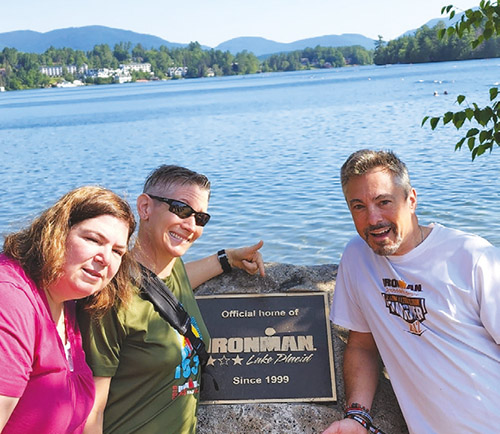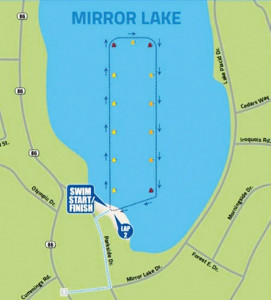
Friday – 8:00 a.m. (47 hours to race start)
The sun was shining and the air was a cool 72 degrees. The advantages to being in the Adirondack mountains were May temperatures in August. While everyone back home in New Jersey was moving from car air conditioning to home air conditioning, we were walking around comfortably. I escorted my wife Janet and our athlete, Ruth to “the rock” that sits on the edge of Mirror Lake.
(Isn’t the race in Lake Placid?)

Yes, but the swim is actually in the lake right next to it. Mirror Lake was a quarter of a mile from the city of Lake Placid. There is a plaque that has become a sacred good luck point for athletes to visit. I’ve always believed that you make your own luck by seizing opportunities, but I was happy to take Ruth and my wife Janet down to the water’s edge for a photo. I kicked off my sandals and let the cool sand slip through my toes. The average body temperature was 98.6 degrees and the sand was around 72 degrees … which made for a soothing experience while the sun warmed my face.
(Why were you standing in the sand?)
Mirror Lake has an artificial beach, which is really helpful when exiting the water at the race.
“What are you doing?” my wife asked as I edged towards the water line.
“I’m going to put my feet in the water.”
“Tell me if it’s cold,” Ruth said.
Janet laughed.
“Ruth, you just asked the man who runs through snowstorms in shorts if the water was cold.”
This was our fifth time racing here and Janet knew that the lake water is consistently 71-73 degrees.
(Is that good?)
It’s perfect. I’ve raced in Maine (58 degrees) and I’ve raced in Cozumel (84 degrees). When you race in a wetsuit you want the water to be between 70-73 degrees.
(What if the water is too warm?)
Then it is no longer “wetsuit legal.”
(You could get arrested?)
No, but you could get disqualified for wearing your wetsuit in water temperatures above 83 degrees.
(Why would someone do such a thing?)
Simple, if they were unprepared or too scared to swim without their neoprene wetsuit. Wetsuits don’t keep you dry. They keep you warm and they keep you buoyant.
My mother taught me to prepare for the worst and expect the best.
(Huh?)
If the race is 2.4 miles of swimming, make sure you can swim 2.5 miles without your wetsuit. Then practice that distance in your wetsuit … in the open water.
(Why not just swim without the wetsuit?)
It provides buoyancy and it makes you faster in the water. Wetsuits are made out of a synthetic rubber called neoprene. Navy frogmen started using wetsuits during World War II. In the 1950s, surfers started using them and by the 2000s, triathletes were using them. Anyone who has ever driven past my house in summer has seen mine hanging on the railing of my front door. I let my sprinkler rinse off the sea water. You don’t have to use a wetsuit, but if you wear one and you still don’t feel safe and secure swimming 2.4 miles in a wetsuit, this might not be the sport for you.
In the 1925 Supreme Court case of Schenck vs. U.S. Justice Oliver Wendell Holmes coined the phrase, “You can’t yell fire in a crowded movie theater.” The rule has since been overturned, but the point is, you cannot do what makes you happy at the expense of the safety of others.
Case in point, at the 2017 Half Ironman Atlantic City I saw a woman with a life vest like flotation device on top of her wetsuit.
(Isn’t that against the rules?)
Yes and when she panicked and pulled the inflation cord, she endangered everyone around her.
The officials disqualified her on the spot. Those are the rules and they are there to keep everyone safe.
(You were planning to use yours on Sunday, right?)
David Roher is a USAT certified triathlon and marathon coach. He is a multi-Ironman finisher and veteran special education teacher. He is on Instagram @David Roher140.6.
He can be reached at TriCoachDavid@gmail.com.









